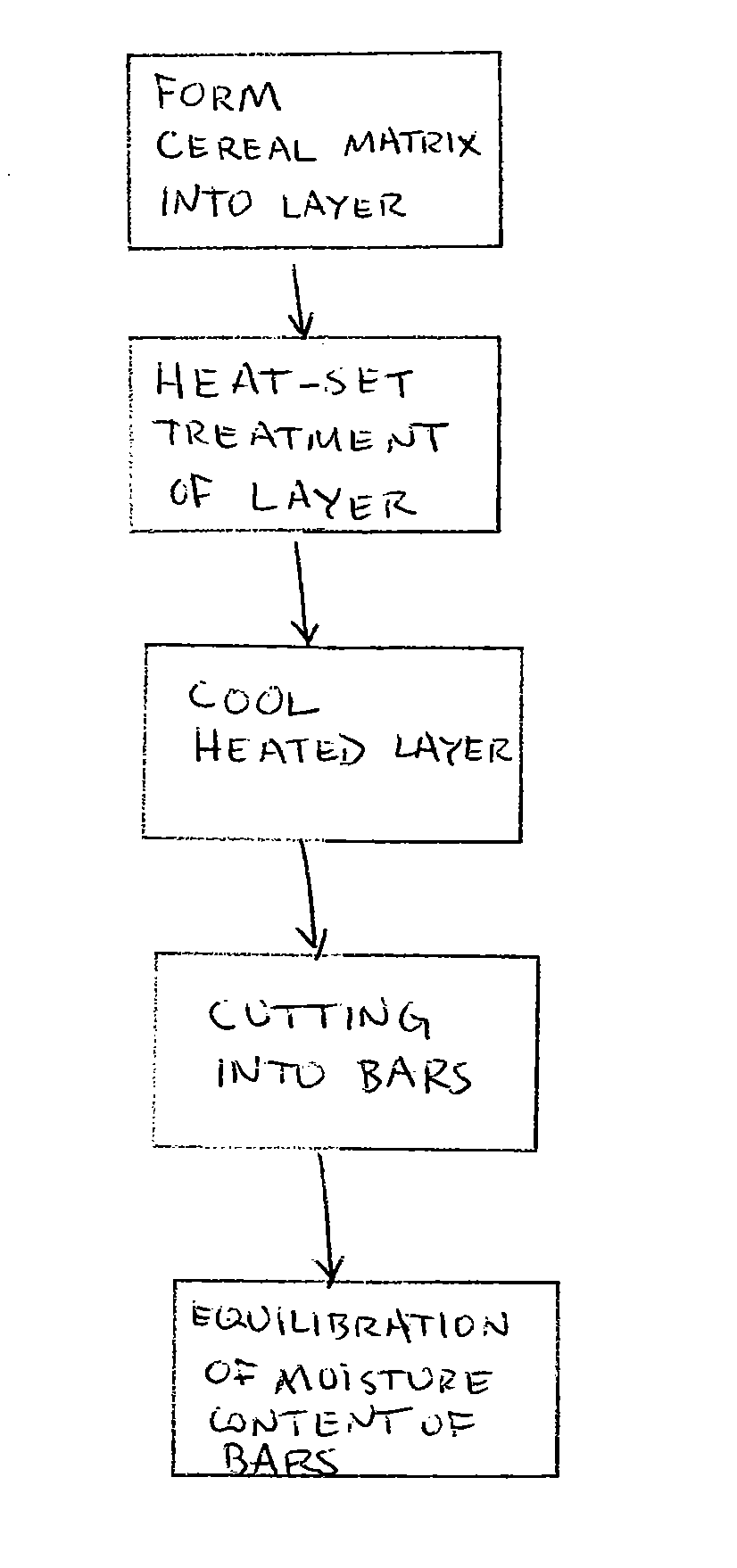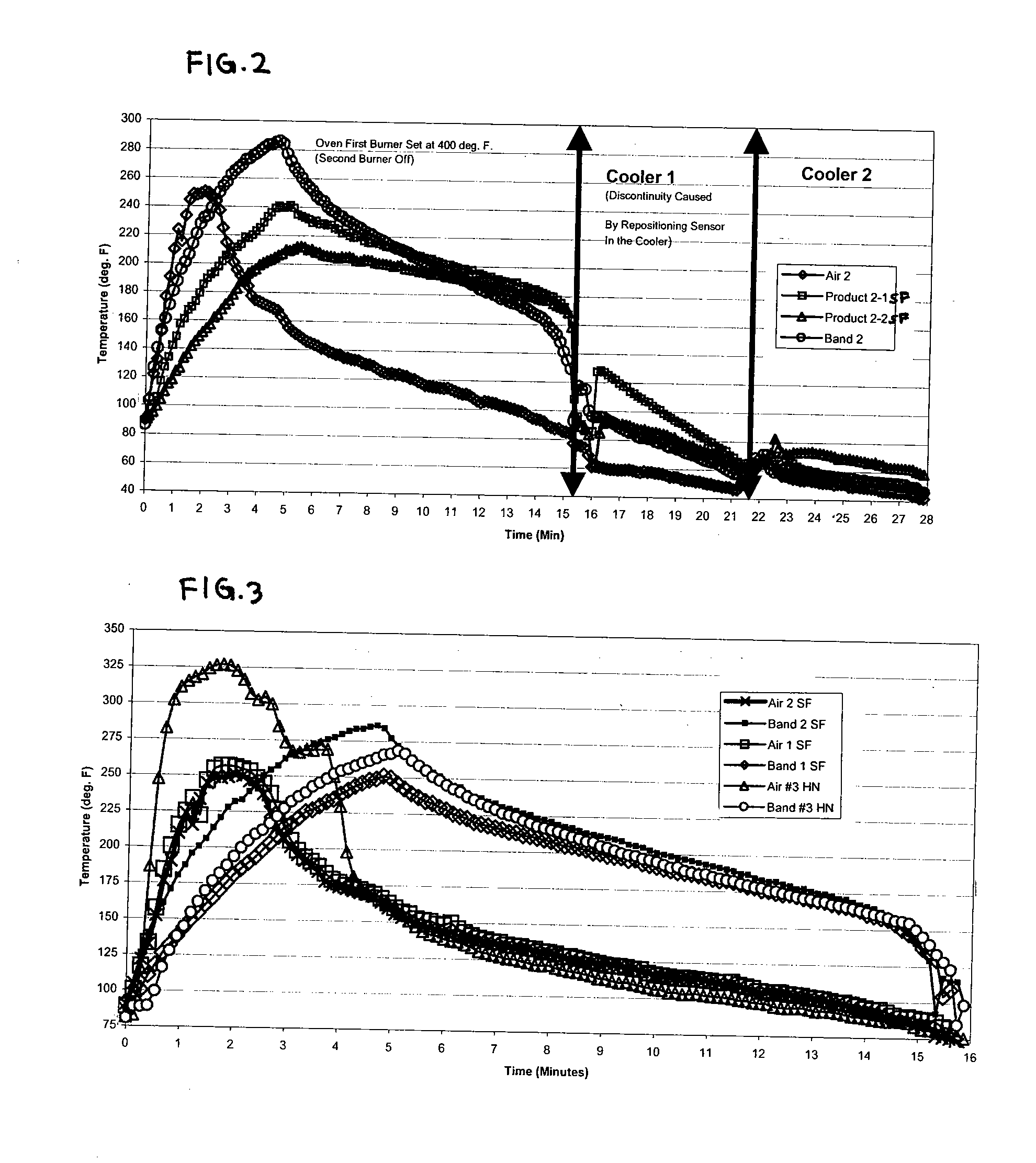Methods for making improved texture cereal bars
- Summary
- Abstract
- Description
- Claims
- Application Information
AI Technical Summary
Benefits of technology
Problems solved by technology
Method used
Image
Examples
example 1
[0045] A binder and cereal mixture were prepared by mixing the binder mixture and cereal ingredients of the “strawberry formula” indicated in Table 1, thus forming a cereal matrix. All non-cereal ingredients were added via the binder mixture. The cereal pieces and total binder were used in a weight:weight ratio of about 1:1, respectively.
TABLE 1PercentCereal IngredientsCorn Flakes Cereal12.0Strawberry Pieces10.0Toasted Oats10.0Crisp Rice7.0Grape Nuts Cereal4.0Grape Nut Fines4.0Cereal flakes3.0Granola4.0Binder Mixture IngredientsCorn Syrup31.4Glycerin3.0Sugar3.0Vegetable Oil2.0Calcium Carbonate2.0Honey2.0Flavor1.0Salt0.2Nonfat Dry Milk1.0Lecithin0.2Citric Acid0.1Vitamins0.1
[0046] The binder mixture was heated to about 170° F. and minimally mixed with the cereal mixture. The temperature of the cereal matrix after mixing with the binder was about 100° F. to about 110° F. The cereal matrix was then sheeted into a single layer of thickness 0.75 inch. Rollers were used for sheeting and ...
example 2
[0047] Cereal bars, designated 2-1 SF and 2-2 SF, were prepared having the same strawberry formula and admixture method of Example 1, which were heat-set in a two-zone indirect gas-fired oven (Werner and Pfleiderer) with an overall retention time in the bake chamber of 15 minutes. The first oven zone was heated and the second oven zone was turned off (unheated). Prior to baking, the surface portion of the sheeted layer had a water activity of 0.54, and the central portion had a water activity of 0.52. Heat was applied for 7.5 minutes in the first oven zone, and 7.5 minutes were available for oven temperatures to cool slowly in the second unheated oven zone. The oven set point was 400° F., and the line speed was about 7 feet per minute. The surface temperature of the cereal bar was measured via a thermocouple placed in the oven space approximately 1 inch from the top surface of the bar. The center portion temperature of the bar product was measured via a thermocouple placed at it geo...
example 3
[0048] Cereal bars having a “honey nut” formula as described in Table 2 below, and separately the strawberry formula of Example 1, were prepared and were heat-set in the two-zone indirect fired oven under the conditions described in Example 2. For the honey nut formula, the cereal pieces and total binder were used in a weight:weight ratio of about 1:1, respectively. All non-cereal ingredients were added via the binder mixture. Prior to baking, the surface portions of the honey nut formula sheeted layers had a water activity of about 0.52, and the central portions had a water activity of about 0.54. The strawberry formula bar had surface and central water activities similar to the bars described in Example 1. Temperature measurements were taken during the oven treatment of the bars at an air temperature oven setting of 400° F.
TABLE 2PercentHoney Nut Cereal IngredientsToasted Oats15.0Cereal Flakes4.0Corn Flakes Cereal14.4Wheat Flakes5.0Crisp Rice11.0Grape Nut Fines4.0Granola4.0Binde...
PUM
 Login to View More
Login to View More Abstract
Description
Claims
Application Information
 Login to View More
Login to View More - R&D
- Intellectual Property
- Life Sciences
- Materials
- Tech Scout
- Unparalleled Data Quality
- Higher Quality Content
- 60% Fewer Hallucinations
Browse by: Latest US Patents, China's latest patents, Technical Efficacy Thesaurus, Application Domain, Technology Topic, Popular Technical Reports.
© 2025 PatSnap. All rights reserved.Legal|Privacy policy|Modern Slavery Act Transparency Statement|Sitemap|About US| Contact US: help@patsnap.com



